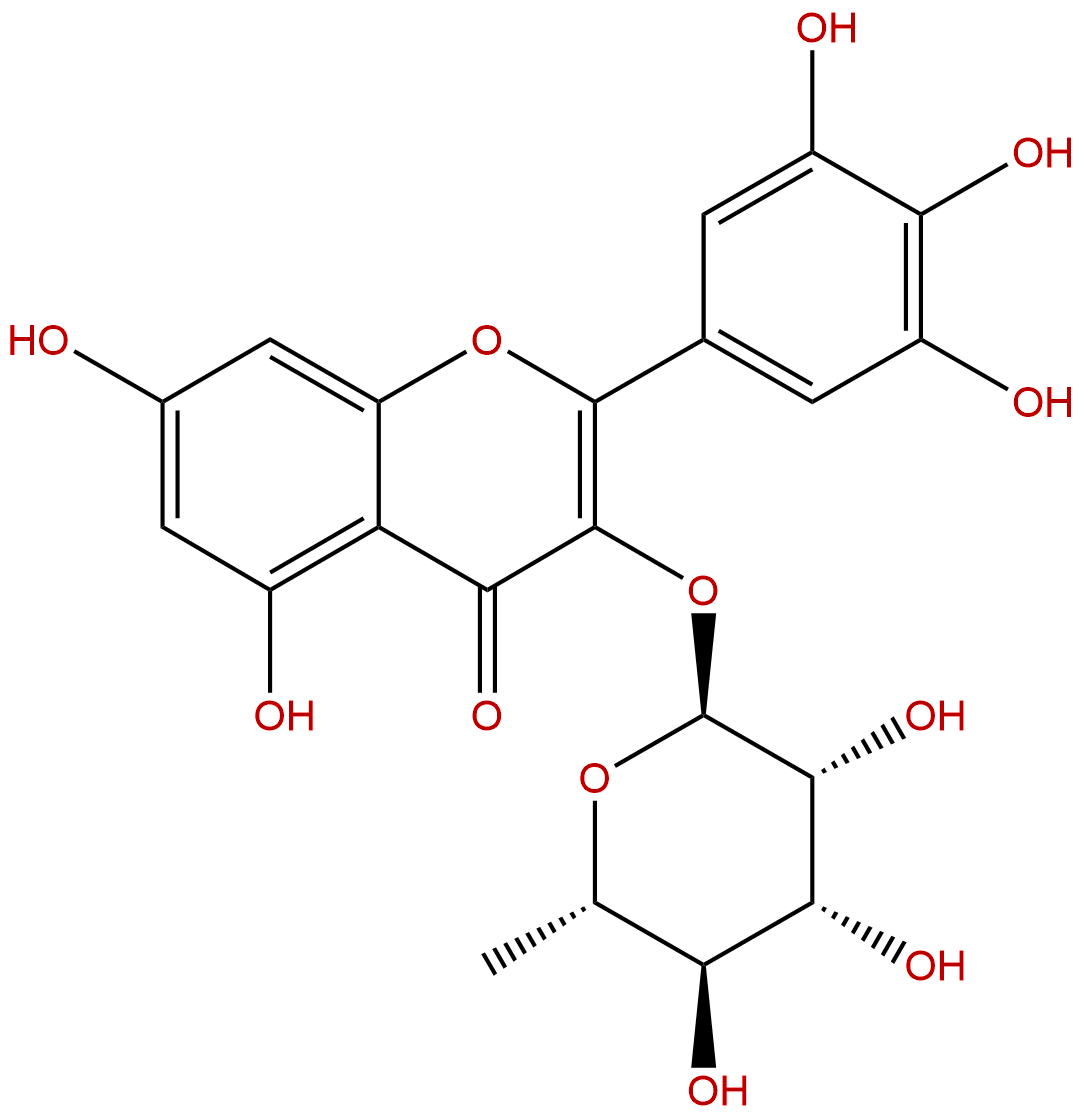
MyricetrinCAS No.:17912-87-7
|
||||||||||
 |
|
|
||||||||

| Catalogue No.: | BP0971 |
| Formula: | C21H20O12 |
| Mol Weight: | 464.379 |
Synonym name: Myricitroside; Myricetin 3- rhamnoside
Catalogue No.: BP0971
Cas No.: 17912-87-7
Formula: C21H20O12
Mol Weight: 464.379
Botanical Source: Occurs in Mimusops elongi, Rhus spp. and Elaeocarpus floribundus and numerous other plants
Purity: 95%~99%
Analysis Method: HPLC-DAD or/and HPLC-ELSD
Identification Method: Mass, NMR
Packing: Brown vial or HDPE plastic bottle
Can be supplied from milligrams to grams.
For Reference Standard and R&D, Not for Human Use Directly.
Inquire for bulk scale.
Description:
Myricitrin exhibits hepatoprotective, anti-inflammatory,antioxidant, anti-allergic, antinociception, anxiolytic-like, and antipsychotic-like effects. Myricitrin can be used as a drug candidate for the treatment of cardiovascular diseases, by effectively protecting cells from ox-LDL-induced endothelial cell apoptosis and reducing atherosclerotic plaque formation. Myricitrin is also a nitric oxide (NO) and protein kinase C (PKC) inhibitor that has central nervous system activity.
References:
Nat Prod Commun. 2015 Jan;10(1):83-8.
Phytochemical profile of the aerial parts of Sedum sediforme and anti-inflammatory activity of myricitrin.
The aim of this study was to investigate the phytochemical profile of the methanol extract of the aerial parts of Sedum sediforme and to identify its secondary metabolites.
METHODS AND RESULTS:
By means of chromatographic separation and enrichment of compounds, HPLC-ESI-MS, HRMS, 1D-, 2D- NMR and/or comparison with reference compounds, three triterpenes, two sterols, ten flavonoids and twelve phenolic compounds were identified, together with two new compounds, i.e. (2R*, 3R*)-5,7-dihydroxy-2,3-dimethyl-4-chromanone-7-O-β-D-glucoside (27) and butan-2-O-rutinoside (28). Out of the 29 identified secondary metabolites, 18 are described as ingredients of S. sediforme herein for the first time. Furthermore, Myricitrin, one of the major constituents, was tested for its ability to inhibit different enzymes within the arachidonic acid cascade in order to determine its anti-inflammatory properties.
CONCLUSIONS:
Whereas there was only either weak or no inhibition of the microsomal prostaglandin E2 synthase-1 (mPGES-1) and the soluble epoxide hydrolase (sEH), Myricitrin showed strong inhibition of 5-lipoxygenase (5-LO), with an IC50 of 7.8 ± 0.2 μM.
Biochem Biophys Res Commun. 2015 Mar 6;458(2):227-33.
Myricitrin alleviates MPP⁺-induced mitochondrial dysfunction in a DJ-1-dependent manner in SN4741 cells.
Oxidative stress and mitochondrial dysfunction have been linked to Parkinson's disease. DJ-1 is a recessive familial PD gene involved in antioxidative function and mitochondrial maintenance. Myricitrin, a flavanoid isolated from the root bark of Myrica cerifera, has potent antioxidative properties.
METHODS AND RESULTS:
In the present study, we investigated the protective effects of Myricitrin against MPP(+)-induced mitochondrial dysfunction in SN4741 cells and attempted to elucidate the mechanisms underlying this protection. The results showed that incubating SN4741 cells with Myricitrin significantly reduced cell death induced by the neurotoxin MPP(+). Furthermore, Myricitrin protected cells from MPP(+)-induced effects on mitochondrial morphology and function. However, these protective effects were lost under DJ-1-deficient conditions.
CONCLUSIONS:
Thus, our results suggest that Myricitrin alleviates MPP(+)-induced mitochondrial dysfunction and increases cell viability via DJ-1, indicating that Myricitrin is a potential beneficial agent for age-related neurodegenerative diseases, particularly Parkinson's disease.
Vascul Pharmacol. 2015 Apr 4.
Myricitrin attenuates endothelial cell apoptosis to prevent atherosclerosis: An insight into PI3K/Akt activation and STAT3 signaling pathways.
Blood vessel endothelial dysfunction induced by oxidized low-density lipoprotein (ox-LDL) has been implicated in the pathogenesis of atherosclerosis and vasculopathy. The ox-LDL-elicited reactive oxygen species (ROS) release has been assumed to serve a critical function in endothelial damage. Myricitrin (from Myrica cerifera) is a natural antioxidant that has strong anti-oxidative, anti-inflammatory, and anti-nociceptive activities. However, the protective effect of Myricitrin on ROS-induced endothelial cell injury and its related molecular mechanisms have never been investigated.
METHODS AND RESULTS:
This study demonstrates that Myricitrin can inhibit ox-LDL-induced endothelial apoptosis and prevent plaque formation at an early stage in an atherosclerotic mouse model. The administration of Myricitrin in vivo decreases the thickness of the vascular wall in the aortic arch of ApoE-/- mice. In vitro study shows that ox-LDL-induced human umbilical vein endothelial cell apoptosis can be reduced upon receiving Myricitrin pre-treatment. Treatment with Myricitrin significantly attenuated ox-LDL-induced endothelial cell apoptosis by inhibiting LOX-1 expression and by increasing the activation of the STAT3 and PI3K/Akt/eNOS signaling pathways. At the same time, our result demonstrates that Myricitrin treatment optimizes the balance of pro/anti-apoptosis proteins, including Bax, Bad, XIAP, cIAP-2, and survivin.
CONCLUSIONS:
Our study suggests that Myricitrin treatment can effectively protect cells from ox-LDL-induced endothelial cell apoptosis, which results in reduced atherosclerotic plaque formation. This result indicates that Myricitrin can be used as a drug candidate for the treatment of cardiovascular diseases. Nat Prod Res. 2011 Feb;25(4):374-80.
Anti-allergic effect of the flavonoid myricitrin from Myrica rubra leaf extracts in vitro and in vivo.
Flavonoids are ingested by the general population as anti-oxidant and anti-inflammatory agents.
METHODS AND RESULTS:
In this study, we investigated the effects of Myricitrin, a flavonoid rich in Myrica rubra leaf, upon anti-inflammatory action. Myrica rubra leaf extracts inhibited pro-inflammatory TNFα production in a macrophage cell line, Raw264.7 cells. We observed that the serum IgE levels in the leaf extract-treated DO11.10, a mouse allergy model, were down-regulated. HPLC was performed to demonstrate that M. rubra leaf extracts contain a large amount of Myricitrin. We observed an inhibitory effect of HPLC-purified Myricitrin on TNFα production in Raw264.7 cells.
CONCLUSIONS:
Thus, Myricitrin may be of potential interest in the management of inflammatory conditions.